The following 6 sentences are quoted from The Meat We Eat textbook: “The meat industry generally acknowledges three types of beef rounds that vary according to the manner in which the sirloin tip is cut.” “The Chicago round is the most common round available in the wholesale trade.” “However, the Chicago round cutting style can be criticized because the cut divides the sirloin tip muscle system, leaving one portion on the sirloin end of the wholesale loin and the other portion of the sirloin tip on the wholesale round. A further problem is the cutting angle because it reduces the potential value of both portions of the tip.” An alternative style results in a Diamond round, which includes the portion of the sirloin tip that is left on the loin with the Chicago style.” “The third option, the New York round, is a compromise – the sirloin tip muscle system is separated from the hindquarter before the round and loin are separated.”
The two reasons the Chicago style round break is by far the most common are: speed & ease of wholesale cut fabrication on big plant moving lines, plus that style of breaking leaves more meat weight on the higher priced primal loin. In the modern world of muscle-boning one might think that the New York style round break would be most logical, but more money to the packer makes the most financial “cents.” Simply pull the sirloin tip (AKA knuckle) first if you break beef carcasses yourself. Ever wonder why the “ball tip” (the portion of the quadriceps muscle group that is widely left on the wholesale sirloin by a Chicago style sirloin – round break) isn’t commonly called the sirloin tip and the sirloin tip isn’t commonly referred to as a round tip? Answer: fanciful names are part of profitable meat merchandising strategies. Merchandising example: the eye of round can be deceiving to undereducated meat buyers because the word “eye” can conger up thoughts of rib-eye and the basic appearance of eye of round steaks is a shape like that of tenderloin steaks. The eye of round is not any easier to successfully prepare than the abutting bottom round flat. But, for the reasons just mentioned, the eye of round is commonly separated off gooseneck rounds for retail cuts; while the flat and heel portions of wholesale goosenecks are much more often ground. Due to supply & demand it’s not uncommon for market cattle bottom round flats to be used in further processing plant grinding formulations as an 85% lean component.
Unlike the muscles of the gooseneck round, the beef quadriceps muscle group (sirloin tip) contains a good bit of both light and intermediate connective tissue. The sirloin tip is somewhat like chuck cuts due to both muscle group’s roll in live animal locomotion and the types & amounts of connective meat tissues found in those carcass regions. However, one major difference is that sirloin tips are comparatively low In marbling and lack large muscle seam-fat deposits. The combination of being lean, boneless and low priced makes the sirloin tip appealing for one to try and successfully process it into value-added beef items.
In this experimental session I decided to make about 9 pounds of smoked shredded beef out of clean sirloin tip side muscles, make stew beef out of most of the remaining side muscles and grind the remainder of the cleaned up sirloin-tip; along with just over 5 pounds of pork fat that had been very recently generated from fatting-down 8 pork shoulder butts. I’m a little concerned about the high quality freezer shelf-life of the pork & beef grind because the pork fat has some packing plant added salt in it; which can increase fat oxidation rates in freezer storage. And, pork fat is softer (less saturated) than beef fat; so it is prone to oxidize more rapidly. Time and freezer hold temperature will judge of the wisdom of this practice. I’m going to try and hold it consistently below 0F and use it all up within about 4 months.
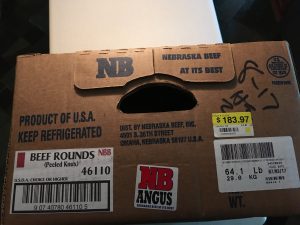
Picked up a case of Choice or Higher peeled sirloin-tips for less per pound than the case price on 73% lean ground beef – for that day. The majority of the meat in run-of-the-mill retail ground beef originates from culled dairy & beef cows (cows are mature breeding stock) and so it is of a lower eating quality. If you want to learn more about different type of ground beef (Click Here).

The heavy connective tissue under the knife blade is bone-skin off the femur and needs to be removed whenever found.
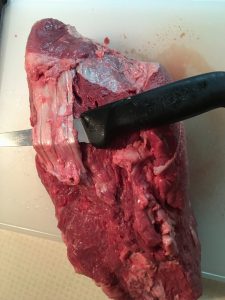
This is “silver-skin” on an outside muscle. Remove the heavy stuff, but don’t get carried away. The grinder will chop up some and some might get wrapped around the grinder blade.
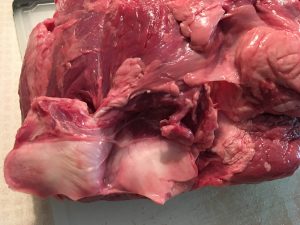
Toward the bottom of this pic is knee-cap (patella) cartilage. Get rid of it too.

Here is all the objectionable material I removed from 6 whole sirloin-tip roasts. All of it together weighed less than one pound. The blade on the boning knife is 5 inches long and was put in the pic to show scale.
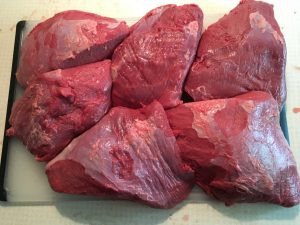
6 sirloin-tip side muscles practically denuded of fat. This is all clean, lean meat.
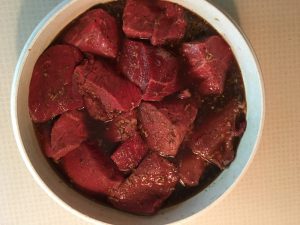
9 pounds of chunks cut from side muscles; down in marinate for making into smoked shredded beef. Marinate for 9 pounds of beef: 1 1/2 cups water, 1 cup bourbon, 3 tsp. roast sodium phosphate, 4 cloves crushed garlic, 2 tsp. coarse ground black pepper, 5 tsp. purified salt, 5 tsp. brown sugar, 1/4 cup Worcestershire sauce and 1/4 cup soy sauce. Remember that there are 4 separate sources of salt in this recipe; so don’t overdue it with purified salt. Let meat marinate for about a day & a half and overhaul (turn) it a few times during that time period.

Most of the remaining side muscles cut into stew beef; then packaged for freezer storage.
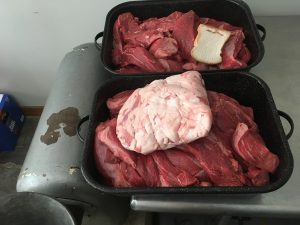
The rest of the sirloin tips, just over 5 pounds of pork fat and two frozen slices of bread. The bread is to help push most of the meat out of the grinder head at the end of grinding. Everything went once through a 3/16 in hole size grinding plate. Fat was intermittently dropped in as sirloin-tip went into the grinder head.
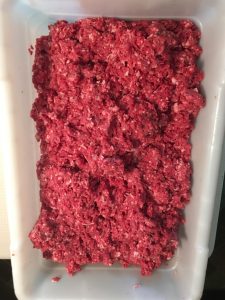
Ground pork and beef; after being mixed around a bit by hand.
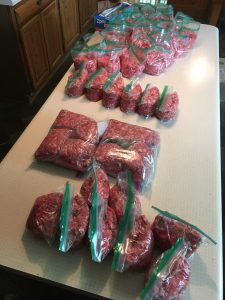
Premium grind being packed-out for the freezer.
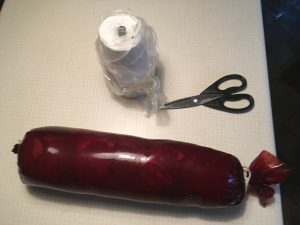
9 pounds of marinated beef chunks hand stuffed into a mahogany colored large fibrous casings. I usually end up with red, but the casing color does not matter. Soak fibrous casings in warm water for about 1/2 hour just prior to stuffing. These casings are tough, hold the open end with one hand and fist meat hard into the end on the table. Both ends were tied tightly shut with cotton butcher’s twine, then any excess casing or twine was cut off.

Low labor, smoke-cooking phase getting under way. After start-up, water and partially lit briquettes were both added twice during the 7 hour smoke. Cooker was not opened during smoking phase because both items were supplied down either a pipe or tubing.
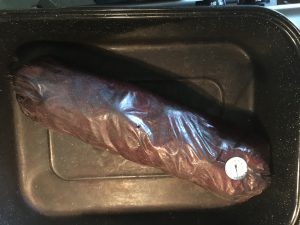
Chub after 7 hours in smoke-cooker. Casing was rinsed off then stripped. Beef went into a covered oven roaster, that had a cooking rack in the bottom, at 240F for 3 hours.
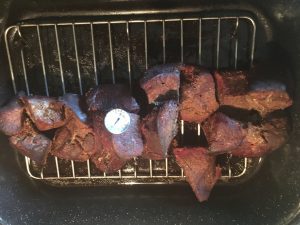
After 3 hours of light steam cooking the internal temperature of chunks averaged 210F.
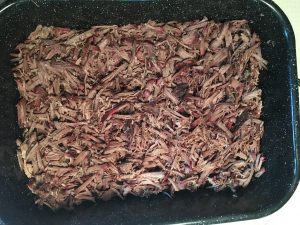
Beef easily shredded; as soon as it was cool enough to handle.
I think these are some good practices for adding value to inexpensive Choice or Higher sirloin tips. And, welcome your input on other sirloin-tip further processing ideas.
